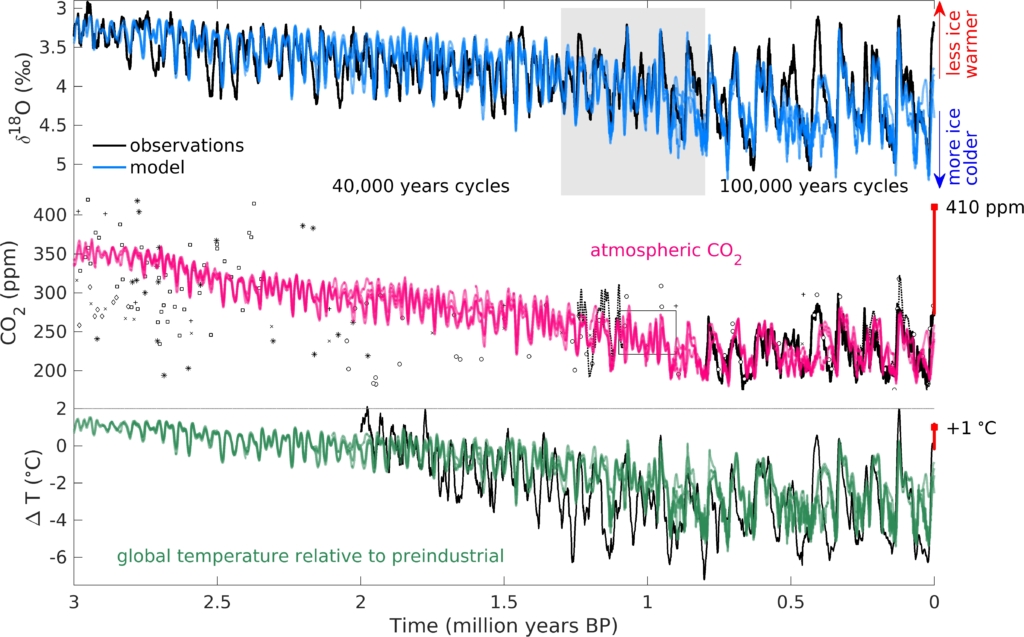First successful model simulation of the past 3 million years of climate change – “Our results imply a strong sensitivity of the Earth system to relatively small variations in atmospheric CO2”

By Matteo Willeit
3 April 2019
(RealClimate) – A new study published in Science Advances shows that the main features of natural climate variability over the last 3 million years can be reproduced with an efficient model of the Earth system.
The Quaternary is the most recent geological Period, covering the past ~2.6 million years. It is defined by the presence of glacial-interglacial cycles associated with the cyclic growth and decay of continental ice sheets in the Northern Hemisphere. Climate variations during the Quaternary are best seen in oxygen isotopes measured in deep-sea sediment cores, which represent variations in global ice volume and ocean temperature. These data show clearly that there has been a general trend towards larger ice sheets and cooler temperatures over the last 3 million years, accompanied by an increase in the amplitude of glacial-interglacial variations and a transition from mostly symmetry cycles with a periodicity of 40,000 years to strongly asymmetric 100,000-year cycles at around 1 million years ago. However, the ultimate causes of these transitions in glacial cycle dynamics remain debated.
Among others, the role of CO2 changes in shaping Quaternary climate dynamics is not yet fully understood, largely because of the poor observational constraints on atmospheric CO2 concentrations for the time before 800,000 years BP, beyond the period covered by high-quality ice core data.
In a paper published today in Science Advances (Williet, et al., 2019), we were able to reproduce the natural climate variability of the whole Quaternary with an Earth system model of intermediate complexity. Besides ocean and atmosphere, the model includes interactive ice sheets for the Northern Hemisphere and a fully coupled global carbon cycle and was driven only by changes in orbital configuration and different scenarios for slowly varying boundary conditions, namely CO2 outgassing from volcanoes as a geologic source of CO2, and changes in sediment distribution over the continents. […]
Our results imply a strong sensitivity of the Earth system to relatively small variations in atmospheric CO2. [more]
First successful model simulation of the past 3 million years of climate change
ABSTRACT: Variations in Earth’s orbit pace the glacial-interglacial cycles of the Quaternary, but the mechanisms that transform regional and seasonal variations in solar insolation into glacial-interglacial cycles are still elusive. Here, we present transient simulations of coevolution of climate, ice sheets, and carbon cycle over the past 3 million years. We show that a gradual lowering of atmospheric CO2 and regolith removal are essential to reproduce the evolution of climate variability over the Quaternary. The long-term CO2 decrease leads to the initiation of Northern Hemisphere glaciation and an increase in the amplitude of glacial-interglacial variations, while the combined effect of CO2 decline and regolith removal controls the timing of the transition from a 41,000- to 100,000-year world. Our results suggest that the current CO2 concentration is unprecedented over the past 3 million years and that global temperature never exceeded the preindustrial value by more than 2°C during the Quaternary.
Mid-Pleistocene transition in glacial cycles explained by declining CO2 and regolith removal